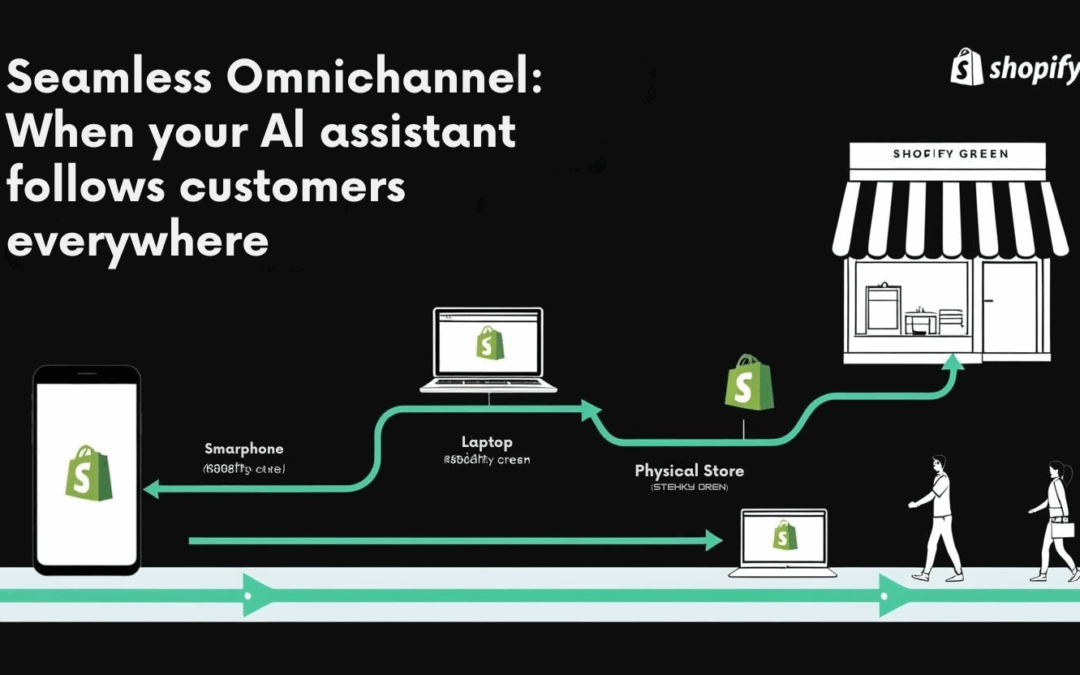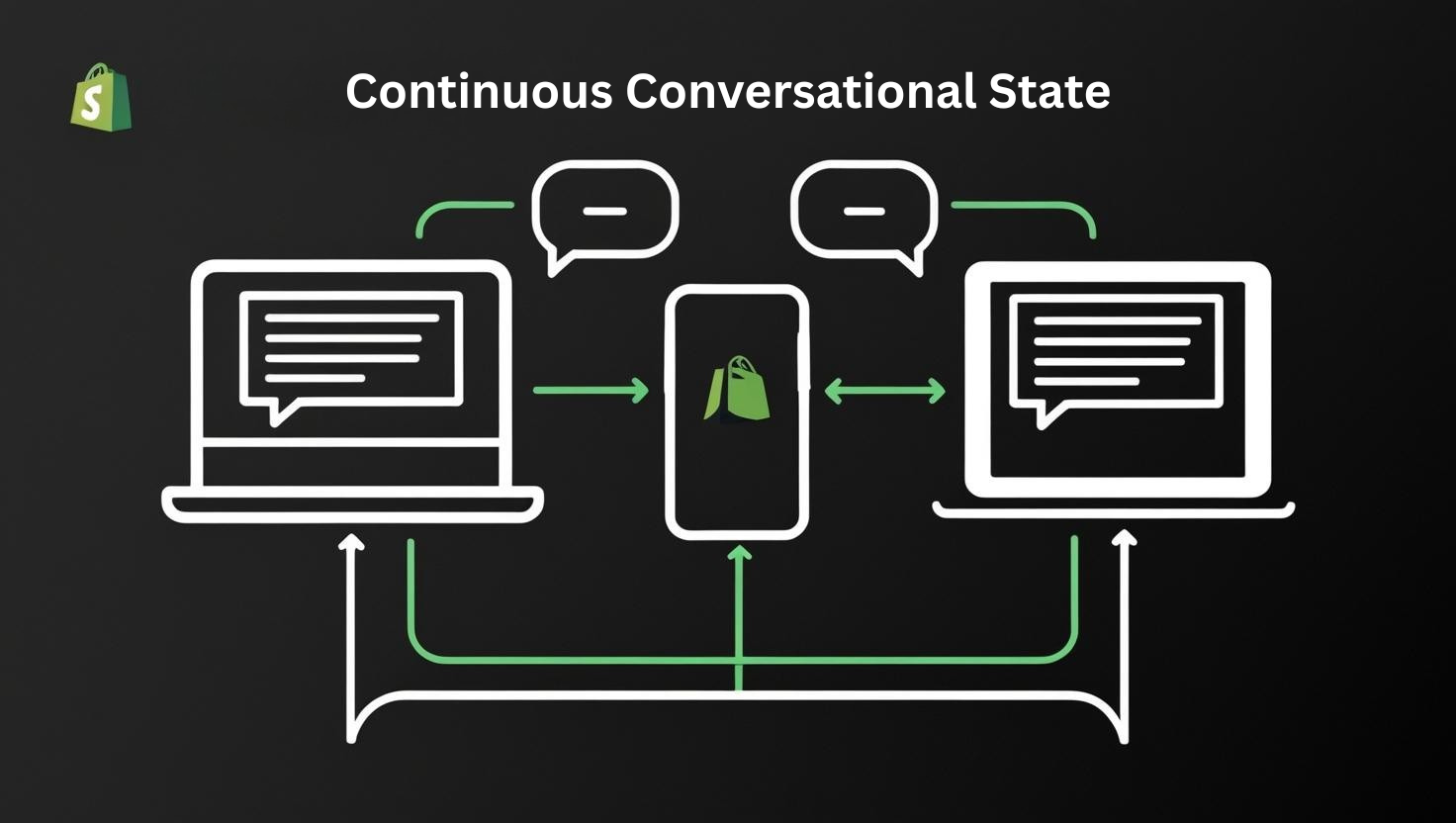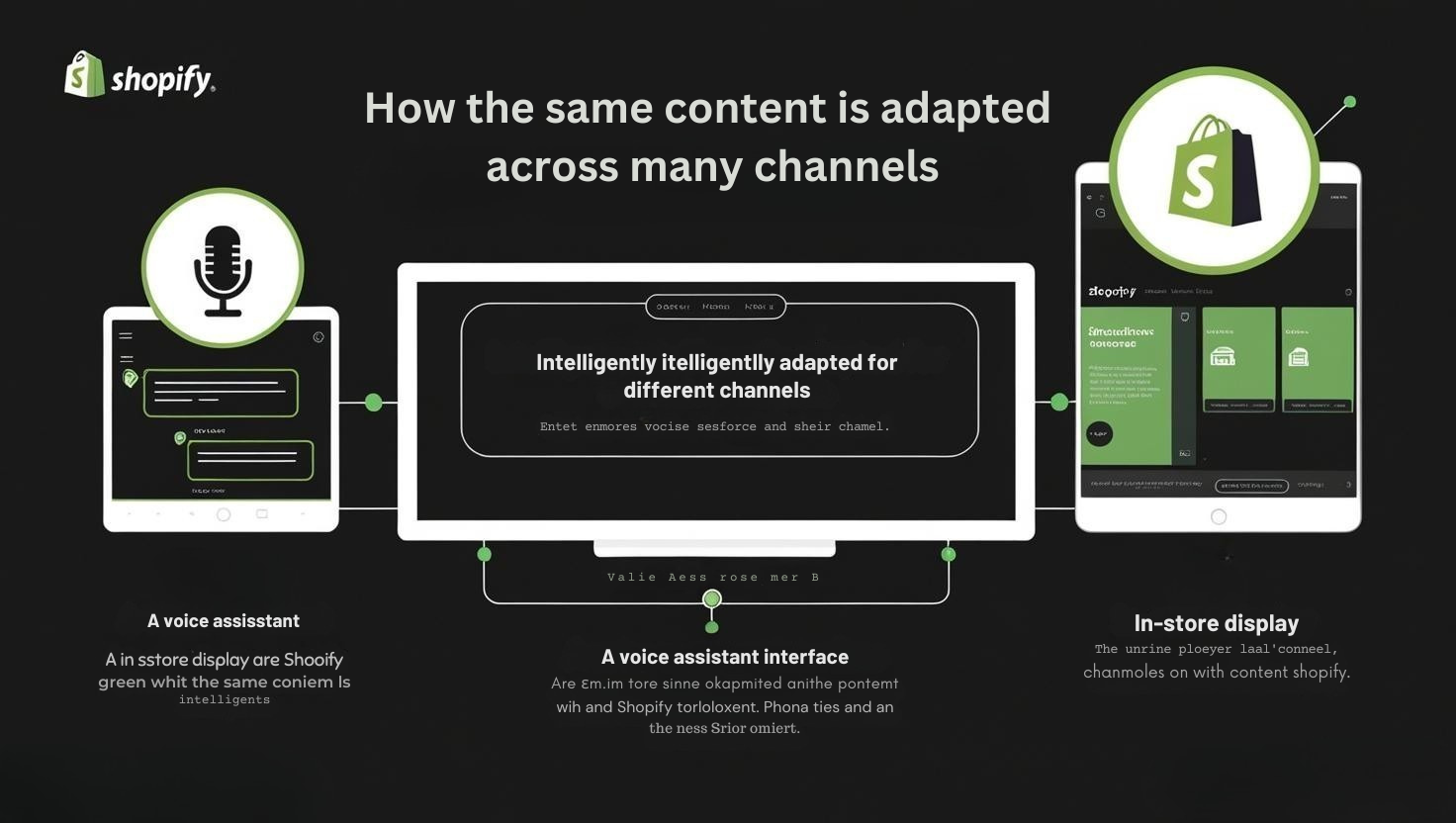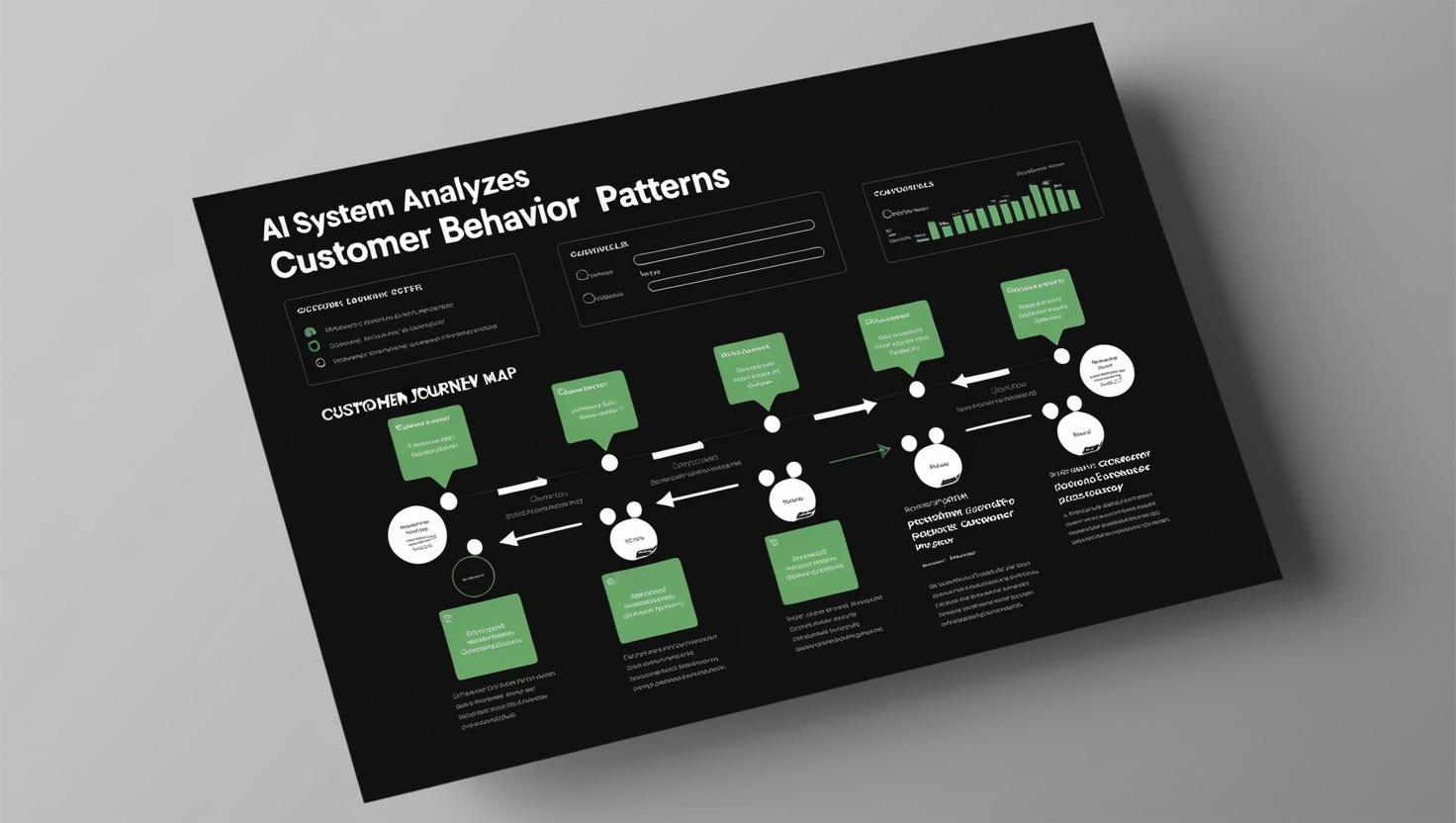Read More
Step-by-Step on SellerADvantage.co.uk
Read on LinkedIn
Read on Medium
Watch on YouTube
Seamless Omnichannel: When Your AI Assistant Follows Customers Everywhere
Introduction
The e-commerce landscape has undergone a profound transformation in recent years, with customer journeys becoming increasingly non-linear and fragmented across multiple touchpoints. Today’s shoppers seamlessly move between smartphones, desktops, physical stores, social media platforms, and messaging apps—often within a single purchasing decision. This complexity presents both a challenge and an opportunity for Shopify merchants: those who can deliver cohesive, personalized experiences across all channels stand to capture significant competitive advantage, while those constrained to siloed interactions risk frustrating customers and losing sales. Traditional approaches to omnichannel commerce have focused primarily on technical integration and consistent inventory visibility, but these foundational elements alone no longer satisfy customer expectations. The next frontier in omnichannel excellence involves implementing AI sales assistants that can truly follow customers everywhere, maintaining perfect conversational continuity and personalized service regardless of where interactions occur.
The business case for implementing seamless AI-powered omnichannel experiences is compelling and increasingly well-documented. Research indicates that omnichannel customers are significantly more valuable than single-channel shoppers, with studies showing they spend an average of 4-6 times more annually than those who engage through just one channel. More specifically, merchants implementing advanced omnichannel AI assistants report conversion rate improvements of 35-49% for cross-channel journeys compared to traditional siloed approaches. These improvements stem from reducing the substantial friction that typically occurs when customers change devices or channels, as each transition historically required customers to re-establish context and restart their shopping progress. Furthermore, continuous cross-channel personalization drives substantial increases in average order value (typically 15-25%) by maintaining consistent recommendation engines that accumulate learning about customer preferences regardless of interaction channel. Perhaps most significantly, merchants utilizing sophisticated omnichannel AI report 28-42% improvements in customer retention metrics, as seamless experiences create powerful loyalty effects that keep customers returning to platforms where they feel understood rather than required to repeatedly reestablish their needs and preferences.
What makes today’s AI-powered omnichannel tools particularly noteworthy is their remarkable accessibility and sophistication compared to earlier attempts at cross-channel integration. Advanced natural language processing allows contemporary AI assistants to maintain complex conversational context across multiple sessions and devices, remembering details from previous interactions regardless of where they occurred. These systems can effectively translate intent across modalities—understanding that a product browsed on mobile might be the subject of a later voice query, or that items discussed in a chat session should influence recommendations during a subsequent website visit. Equally important, these capabilities are increasingly available through purpose-built Shopify applications and integrations requiring minimal technical expertise to implement effectively. This democratization of advanced omnichannel technology means independent merchants can now deliver cross-channel experiences of similar sophistication to those offered by enterprise retailers, without requiring massive development investments or specialized technical teams. The playing field has been leveled in ways that create unprecedented opportunities for innovative Shopify store owners to compete based on customer experience rather than simply scale or technology budgets.
Key Action Points
1. Implement Continuous Conversational State Across Channels
The foundation of truly seamless omnichannel experiences lies in maintaining uninterrupted conversational context as customers move between different interaction channels. Traditional e-commerce experiences force customers to restart their journey with each channel change—re-explaining preferences, repeating questions, and rebuilding context that was already established elsewhere. This friction creates frustration and abandonment, particularly during complex purchasing decisions that naturally span multiple sessions or devices. Advanced AI assistants overcome this limitation through sophisticated state management systems that maintain a unified conversational memory across all touchpoints. These systems capture not just explicit customer statements but also implicit signals like browsing patterns, hesitation behaviors, and engagement metrics, building a comprehensive understanding of customer intent that persists regardless of channel transitions. When effectively implemented, this approach allows conversations to continue naturally even when customers switch from web chat to mobile app, social media to telephone, or online browsing to in-store visits, creating the impression of a single, continuous interaction rather than disconnected episodes.
Implementation begins with establishing a unified customer identity framework that reliably connects interactions across different channels to the same individual. This typically involves both authenticated identification (accounts, logins) and probabilistic matching techniques for anonymous sessions based on device fingerprinting, behavioral patterns, and other signals. Once identity foundations are established, deploy conversation management systems designed specifically for cross-channel persistence, utilizing cloud-based architectures that maintain state independently from any specific channel interface. Configure your AI assistant to proactively reference previous interactions when conversations resume on new channels, acknowledging the channel transition while maintaining context to signal continuity to the customer. For example, when a customer who abandoned a mobile chat about product options later returns on desktop, the system might say, “Welcome back! I remember you were considering the premium model earlier on your phone. Would you like to continue exploring those options?” This explicit acknowledgment of continuity dramatically improves customer confidence in the system while reducing repetitive interactions.
The commercial impact of continuous conversational state extends far beyond simple convenience improvements. Merchants implementing sophisticated cross-channel conversation management typically report 45-65% reductions in abandoned customer journeys during channel transitions, as customers no longer need to overcome the friction of re-establishing context when switching devices. Average session duration after a channel transition increases by 3.2-4.5 times compared to traditional siloed approaches, reflecting enhanced customer confidence that their previous progress has been preserved. Perhaps most significantly, conversion rates for journeys involving multiple channels increase by 30-50% when conversation continuity is maintained, as customers can seamlessly progress through their decision process regardless of situational changes that necessitate device or channel switching. These performance improvements stem from aligning technology with natural human behavior patterns, where purchasing decisions frequently span multiple contexts and sessions rather than occurring in single, linear interactions.
2. Deploy Channel-Optimized Response Adaptation
While maintaining conversational continuity across channels is essential, equally important is adapting how information is presented based on the unique characteristics and limitations of each interaction channel. Simply maintaining the same conversation isn’t sufficient if responses aren’t optimized for the current interface modality. Effective omnichannel AI systems implement sophisticated response adaptation frameworks that dynamically reconfigure information presentation based on channel-specific constraints and opportunities. This approach recognizes that the optimal way to present product options differs dramatically between a full-screen desktop browser, a space-constrained mobile interface, a voice-only smart speaker interaction, or an SMS conversation with character limitations. Advanced adaptation engines automatically restructure content—adjusting information density, visualization approaches, navigation options, and even linguistic patterns—while maintaining consistent underlying information and conversational context across all these modalities.
Implementation requires establishing comprehensive channel capability profiles that define the constraints and opportunities of each interaction environment. Configure your AI system to recognize the active channel for each interaction and automatically apply appropriate presentation rules based on these profiles. For visual channels like websites and mobile apps, implement responsive information architectures that dynamically adjust content organization based on screen real estate, with different information hierarchies for different device types. For conversational interfaces like chat and voice, deploy turn-optimization algorithms that balance information completeness against conversation flow, preventing overwhelming responses while ensuring all critical information is accessible. Develop channel-appropriate media strategies that recognize which content formats work best in which environments—for example, 360-degree product views on desktop, swipeable galleries on mobile, concise text descriptions in chat, and brief audio summaries in voice interfaces. Finally, implement cross-channel handoff protocols that proactively offer to continue interactions on more suitable channels when current limitations impact experience quality, such as suggesting, “This might be easier to see on a larger screen. Would you like me to send these options to your email so you can continue on desktop?”
The performance impact of channel-optimized presentation is substantial and directly measurable. Merchants implementing sophisticated adaptation frameworks typically report 25-40% higher engagement metrics across all channels as information presentation aligns more effectively with each interface’s natural interaction patterns. Channel-specific conversion rates increase by 15-30% when content is optimized for the unique characteristics of each environment rather than simply reformatted to fit different screens. Perhaps most significantly, cross-channel continuation acceptance rates—where customers follow suggested transitions to more appropriate channels for specific tasks—reach 40-65% when contextual continuity is guaranteed, creating opportunities to guide customers to optimal interaction environments for different journey stages. These metrics reflect the fundamental reality that different channels excel at different aspects of the shopping experience, and merchants who can seamlessly transition customers between these environments while maintaining context create superior overall experiences compared to those constrained to single-channel optimization or basic responsive design.
3. Implement Predictive Cross-Channel Journey Orchestration
The most sophisticated application of omnichannel AI moves beyond reactive continuity to proactively orchestrate optimal customer journeys across channels based on predictive understanding of customer needs and situational context. This approach recognizes that customers don’t think in terms of channels but rather in terms of goals and convenience, selecting interaction environments based on immediate circumstances rather than predetermined paths. Advanced AI systems can predict likely journey progressions based on observed patterns, proactively preparing personalized paths that anticipate channel transitions before they occur. For example, the system might recognize that customers researching high-consideration products typically begin on mobile during commuting hours but prefer to complete purchases on desktop in the evening, or that certain product categories generate frequent post-purchase support needs through specific channels. By identifying these patterns, the AI can prepare seamless transitions before they’re needed, ensuring not just continuity but truly optimized cross-channel journeys tailored to each customer’s unique behavior patterns and preferences.
Implementation begins with developing sophisticated journey analytics that map common cross-channel patterns for different customer segments, product categories, and purchase stages. Configure your AI system to identify pattern matches between current customer behaviors and established journey models, triggering proactive preparation for likely next steps. Deploy cross-channel messaging capabilities that can deliver timely transition prompts through appropriate channels when circumstances suggest a channel shift would benefit the customer. For example, sending a timely email with saved shopping cart details when analytics suggest a customer is likely to continue their mobile research on desktop later. Implement “journey bookmarking” features that automatically save progress and context at crucial decision points, making it effortless for customers to resume regardless of when or where they return. Finally, develop “channel affinity” profiles for individual customers that recognize their unique channel preferences for different activities, allowing the system to suggest transitions aligned with established behavioral patterns rather than generic journey maps.
The business impact of predictive journey orchestration extends across the entire customer lifecycle. Merchants implementing sophisticated cross-channel prediction typically report 20-35% increases in journey completion rates as customers encounter fewer obstacles during natural transition points. Average time-to-purchase decreases by 15-30% for complex products requiring research, as orchestrated journeys guide customers through efficient decision processes rather than leaving them to navigate nonlinear paths independently. Perhaps most significantly, customer lifetime value increases by 25-40% when predictive orchestration is implemented effectively, as the system continuously refines its understanding of individual preferences and behaviors, creating increasingly personalized journeys over time that strengthen loyalty and repeat purchase behavior. These performance improvements reflect the power of aligning technology with natural customer behavior patterns, creating experiences that feel intuitively supportive rather than artificially constrained to business-centric channel definitions or linear journey assumptions.
Final Thoughts
The implementation of seamless omnichannel AI assistants represents more than a technological upgrade—it constitutes a fundamental reimagining of the relationship between e-commerce platforms and customers that transcends traditional channel boundaries. By creating experiences that maintain perfect continuity regardless of where interactions occur, these systems align with how customers naturally think and behave, removing artificial friction created by technology limitations rather than human preferences. This alignment is particularly valuable in today’s fragmented attention economy, where customers increasingly expect every brand interaction to acknowledge and build upon their complete relationship history rather than treating each touchpoint as an isolated episode. Merchants who successfully implement seamless omnichannel capabilities gain the ability to maintain meaningful conversation threads through the noise and interruptions of modern life, creating powerful differentiation in markets where customer experience has become the primary competitive battleground.
Looking ahead, omnichannel AI capabilities will increasingly intersect with other emerging technologies to create even more sophisticated cross-channel experiences. Integration with augmented reality could allow virtual product demonstrations begun online to continue in physical environments through mobile AR overlays. Advanced biometric authentication could enable instant identity recognition across channels without requiring explicit login actions. Edge computing advances could enable sophisticated AI interactions even in low-connectivity scenarios, maintaining local conversation state that synchronizes when connections improve. These technological convergences will continuously expand the potential for seamless experiences, creating ongoing opportunities for innovation and differentiation among forward-thinking Shopify merchants who recognize the strategic importance of transcending channel limitations.
The time for implementing seamless omnichannel capabilities is now, while the technology offers significant competitive advantages but hasn’t yet become an expected standard. Early adopters have the opportunity to establish powerful loyalty effects in their customer base, creating seamless experiences that dramatically raise expectations for competitors. By prioritizing the key action points outlined in this article—implementing continuous conversational state, deploying channel-optimized adaptation, and creating predictive journey orchestration—Shopify store owners can transform their customer experience from a collection of siloed interactions into a coherent, continuous relationship that builds value over time. In an increasingly fragmented digital landscape where customer attention is the scarcest resource, the ability to maintain meaningful continuity across touchpoints may well become the defining factor separating market leaders from the undifferentiated masses competing primarily on product and price.
Any follow helps us out a lot – Thank-You!
If you like this article and want to explore further insights, discuss collaborative opportunities, or simply connect, please feel free to reach out to me on any of the following :
Work With Us
Hire Us on fiverr
Hire Us on upwork
🔴Book a FREE PPC Audit🔴







